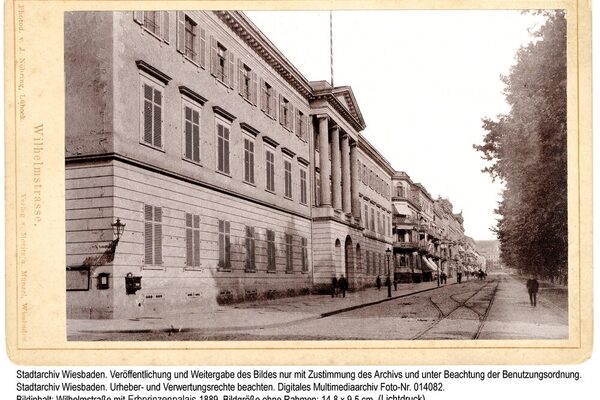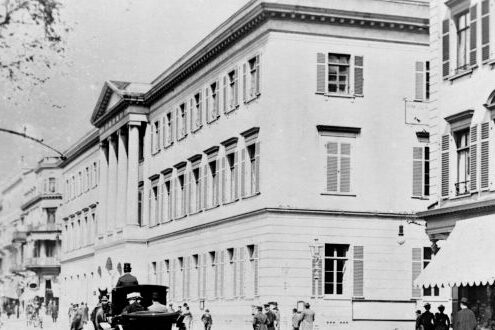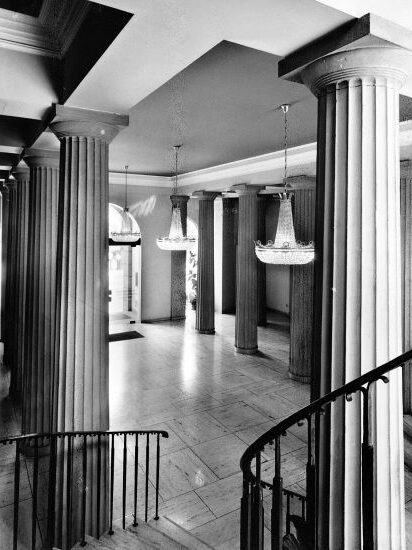Erbprinzenpalais
The Erbprinzenpalais on Wilhelmstraße was the cultural center of Wiesbaden until 1915 with the collections housed there. These included the Nassau State Library, the Association for Nassau Antiquities and Historical Research with its collection of Nassau antiquities and the natural history collection of the later Nassau Association for Natural History. Today, the building is home to the Wiesbaden Chamber of Industry and Commerce.
Built on the corner of Wilhelmstrasse and Friedrichstrasse between 1813 and 1820 in the classical style based on the Greek model, this is the only representative building of its kind still preserved in Wiesbaden, the construction of which was planned and executed by one of the creators of the so-called Historic Pentagon, Christian Zais. It was intended to serve Friedrich Wilhelm Prince of Nassau-Weilburg and his son, Hereditary Prince Wilhelm, as a princely residence in the new capital of the duchy. However, after both Friedrich August Duke of Nassau and his co-regent Prince Friedrich Wilhelm died in the spring of 1816, Hereditary Prince Wilhelm, now appointed Duke, moved into Biebrich Palace in 1817. Although this meant that the original purpose of the palace on Wilhelmstrasse no longer applied, Zais succeeded in continuing the building work until his death in 1820, despite many obstacles. His widow and the domain administration finally saw to its completion.
The cubic form of the three-storey building, the recession of the flat pitched roof behind an attic and the reduction of the building's ornamentation are in deliberate contrast to the opulent pomp of the Baroque period.
The palace subsequently served cultural purposes. On the one hand, the first floor housed the Nassau State Library in 1821, which had originated from a private collection of Charlotte Amalie Princess of Nassau-Usingen and had initially been moved to the old palace in Wiesbaden. On the other hand, the Association for Nassau Antiquities and Historical Research was given exhibition rooms for its collection of Nassau antiquities in 1822. After the acquisition of the extensive art collection of Johann Isaak von Gerning in 1824, which was initiated by Goethe, and its incorporation, the museum was officially opened in the Erbprinzenpalais on April 1, 1825. In 1829, the natural history collection, which was donated by Baron Heinrich Friedrich Karl vom und zum Stein (1757 - 1831), among others, moved to the second floor of the palace. It was looked after by the "Verein für Naturkunde im Herzogthum Nassau", which later became the Nassauischer Verein für Naturkunde. The paintings from Gerning's collection, which formed the basis of the new picture gallery and were looked after by the "Gesellschaft von Freunden bildender Kunst im Herzogthum Nassau", later the Nassauischer Kunstverein e.V., from 1847, were also exhibited there.
After the General Tax Directorate moved out of the second floor in 1856 and these rooms were made available to the library, the Picture Gallery was given its rooms on the first floor. This change in the use of the building resulted in the first serious intervention in the fabric of the building. The former gateway, a hall with Doric columns, which was located in the base of the central risalit, was provided with an appropriate entrance and a new vestibule by Philipp Hoffmann in 1857, which still impresses today with its simplicity and spaciousness. The gateway was closed at the same time. Until 1915, the palace and the collections housed there were the focal point for art, culture and history in Wiesbaden.
In 1913, the State Library received its new building in Rheinstraße, and in 1915, the new museum was opened on today's Friedrich-Ebert-Allee. In the years after 1915, the palace, which was initially earmarked for demolition, served various municipal offices. The building remained intact during the war and became the seat of the Hessian Ministry of Justice in 1947. In 1968, the Chamber of Industry and Commerce (IHK) acquired the property. In a manner befitting its history, the IHK renovated and refurbished the building from which it now serves the regional economy. In 2013, the IHK erected a new building in the form of a glass cube in the courtyard of the palace for its so-called education campus and, in this context, also renovated the neoclassical residential building at Friedrichstraße 5, built in 1811/12.
Literature
- Struck, Wolf-Heino
Wiesbaden in the Age of Goethe, Wiesbaden 1979 (pp. 120-123).
- Visbeck, Hartmut
The Erbprinzenpalais. A symbol of power, culture and commerce. In: From Biebrich to Wiesbaden. Two cities grow together, published by Kur- und Verkehrsverein e.V., Gesellschaft zur Förderung Wiesbadens, Andreas and Georg Schmidt-von Rhein (ed.), Cologne, 2nd edition, Wiesbaden 1999 (pp. 241-254).
- Kiesow, Gottfried
Architectural Guide Wiesbaden. The City of Historicism, Bonn 2006 (p. 37 f.).


